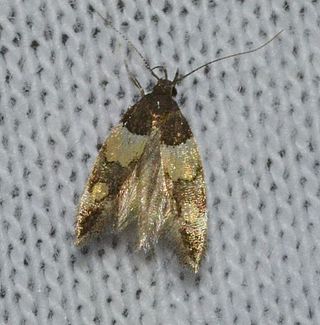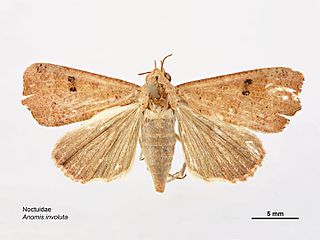
The luna moth, also called the American moon moth, is a Nearctic moth in the family Saturniidae, subfamily Saturniinae, a group commonly named the giant silk moths.

The cinnabar moth is a brightly coloured arctiid moth found as a native species in Europe and western and central Asia then east across the Palearctic to Siberia to China. It has been introduced into New Zealand, Australia and North America to control ragwort, on which its larvae feed. The moth is named after the red mineral cinnabar because of the red patches on its predominantly black wings. The species was first described by Carl Linnaeus in his 1758 10th edition of Systema Naturae. Cinnabar moths are about 20 mm (0.79 in) long and have a wingspan of 32–42 mm (1.3–1.7 in).
The Cosmopterigidae are a family of insects in the order Lepidoptera. These are small moths with narrow wings whose tiny larvae feed internally on the leaves, seeds and stems of their host plants. About 1500 species are described. The taxonomic family is most diverse in the Australian and Pacific region with about 780 species.
Coleophora coracipennella is a moth of the family Coleophoridae. The species is found in Europe and was first described by Jacob Hübner in 1796.
Geshna is a monotypic moth genus of the family Crambidae described by Harrison Gray Dyar Jr. in 1906. It contains only one species, Geshna cannalis, the lesser canna leafroller, described by Altus Lacy Quaintance in 1898. It is found in North America, where it has been recorded from Florida, Mississippi, South Carolina, North Carolina and Tennessee. It has also been recorded from Costa Rica and Cuba.

Triclonella is a genus of moths in the family Cosmopterigidae.

Athetis thoracica is a moth of the family Noctuidae. It is found all over the Indo-Australian and Pacific tropics. It was first recorded from Hawaii in the early 1900s. It is believed to have been accidentally introduced from Fiji. It is now present on Kauai, Oahu, Molokai, Maui and Hawaii.

Oinophila v-flava is a moth of the family Tineidae. It is widespread in temperate zones from Europe to South Africa, North America but also Hawaii. This species has also been recorded in New Zealand in 2001 and is regarded as having established itself in that country.
Dichomeris acuminata, the alfalfa leaf tier, is a moth of the family Gelechiidae. It was first described by Otto Staudinger in 1876. It is a widely distributed species, being known from India, Myanmar, and Sri Lanka southwest to the Seychelles, Mauritius and Réunion and on to Egypt, east and South Africa and southern Europe. Eastward from India it extends through Indonesia and Malaysia to Taiwan and Australia. It is also found in Japan, the West Indies, North America and Hawaii.

Hellula undalis, the cabbage webworm or Old World webworm, is a moth of the family Crambidae. It is a widespread species which is found from Europe across Asia to the Pacific. It was first described from Italy.

Crocidosema lantana, the lantana flower-cluster moth or lantana tortricid moth, is a moth of the family Tortricidae. It was first described by August Busck in 1910. It is native to Mexico and the southern United States, but was introduced to Hawaii in 1902, Australia in 1914 and the Caroline Islands in 1948 and 1949 to aid in the control of Lantana weeds. It has also been recorded from Yunnan, China and in Sri Lanka.

Anomis involuta, the jute looper or hibiscus cutworm, is a moth of the family Erebidae. It has a wide distribution, including the Cook Islands, Hong Kong, Japan, Korea, the Society Islands and Australia. It is also known from Kenya and Somalia.

Cydalima perspectalis or the box tree moth is a species of moth of the family Crambidae, first described by Francis Walker, the English entomologist, in 1859. Native to Japan, China, Taiwan, Korea, far-east Russia and India, it has invaded Europe; first recorded in Germany in 2006, then Switzerland and the Netherlands in 2007, Great Britain in 2008, France and Austria in 2009, Hungary in 2011, then Romania, and Spain. It has been seen in Slovakia, Belgium and Croatia.
Triclonella antidectis is a moth in the family Cosmopterigidae. It is found in Arizona and Mexico.
Triclonella bicoloripennis is a moth in the family Cosmopterigidae. It is found in North America, where it has been recorded from Louisiana, Mississippi, South Carolina and Texas.

Triclonella determinatella is a moth in the family Cosmopterigidae. It is found in North America, where it has been recorded from Alabama, Arkansas, Florida, Illinois, Kansas, Louisiana, Mississippi, Oklahoma and Texas.
Triclonella pictoria is a moth in the family Cosmopterigidae. It is found in Guyana and Brazil.
Triclonella xuthocelis is a moth in the family Cosmopterigidae. It is found in the mountains of southern Arizona and northern Mexico.
Rhectocraspeda periusalis, the eggplant webworm moth, is a moth in the family Crambidae. It was described by Francis Walker in 1859. It is found in the West Indies and from the United States, where it has been recorded from Florida, North Carolina, Ohio, Oklahoma, South Carolina and Tennessee, south through Mexico and Central America to South America, including Ecuador, Brazil, Guyana, Trinidad and Tobago and Suriname.

Aroga trialbamaculella, the red-striped fireworm moth, is a moth of the family Gelechiidae. It is found in the United States, where it has been recorded from Maine to Florida and from Illinois to Texas.









